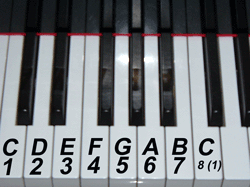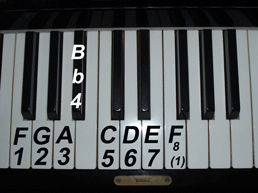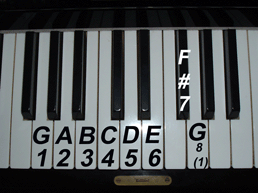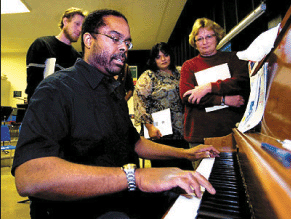by Charley Wyser
In the last lesson, we learned how to form a major scale in the three basic keys - C, F, and G.
This lesson will teach you how to create simple melodies in these keys. Although these melodies are very easy to learn, it is the concept that you should focus on.
Let's start with the key of C. To refresh your memory, look at the picture of the C scale below.

The notes in the C scale are C, D, E, F, G, A, B, and C.
You have noticed numbers under each of these notes. These numbers make it easy for us to get around in any key we are playing in. All I have done is numbered the notes in the C scale from 1 to 8. You will notice that after the 8, there is a 1 in parenthesis. The reason for this is that 8 is the same note as 1. So you can use either.
For this lesson, let's use our right hand and number our fingers from 1 to 5. The finger numbers are as follows: thumb (finger 1), pointer finger (2), middle finger (3), ring finger (4), and little finger (5).
Let's place our right hand on the piano or keyboard with our fingers in a certain order.
The thumb (finger 1) should be placed on C, finger 2 on D, finger 3 on E, finger 4 on F, and finger 5 on G. In other words, fingers 1-2-3-4-5 are placed on notes 1-2-3-4-5 (C, D, E, F, G).
To learn our tunes, we will refer to the notes by using the numbers instead of their letter names. This is important, because these numbers allow us to play tunes in any key. You will soon see the value of this as you play these tunes in the keys of F, and G.
Let's get started!
Play the numbers in each of the tunes below in the orders listed.
Tune 1 - Hot Cross Buns
3 -> 2 -> 1 (hold 1 a little longer)
next
3 -> 2 -> 1 (hold 1 a little longer)
then
1 -> 1-> 1-> 1 ->2 ->2 ->2 ->2
last
3 -> 2 -> 1 (hold 1 a little longer)
Tune 2 - Jingle Bells
3 -> 3 -> 3 (hold 3 a little longer)
next
3 -> 3 -> 3 (hold 3 a little longer)
then
3 -> 5-> 1 (hold a little longer)-> 2 ->3 (hold a little longer)
then
4 -> 4 -> 4 -> 4
then
4 -> 3 -> 3
then
3 -> 3 -> 3 -> 2 -> 2 -> 3 -> 2 (hold a little longer) -> 5
next
3 -> 3 -> 3 (hold 3 a little longer)
next
3 -> 3 -> 3 (hold 3 a little longer)
then
3 -> 5-> 1 (hold a little longer)-> 2 ->3 (hold a little longer)
then
4 -> 4 -> 4 -> 4
then
4 -> 3 -> 3
then
3 -> 3 -> 5 -> 5 -> 4 -> 2 -> 1 (hold a little longer)
As you play these tunes, you will start to recognize them by sound. Play these notes to the rhythms you already know whenever you sing these tunes.
So as you can see, playing by numbers can actually make things a lot simpler!
Below are pictures of the F major scale with the note numbers, and the G major scale with the notes numbered.
Try playing these same two tunes in the keys of F and G.


In the next lesson, we will learn some basic chords, and learn how to apply them to the tunes we just learned.
If you would like to learn more about this subject, be sure to check out my program, "The Secret 7 Numbers Of Successful Piano Playing, by clicking here.
Have Fun!
Charley Wyser
easypiano.com






Hello,
ReplyDeleteI have found very helpful this article. I just played it and it sounds really good.